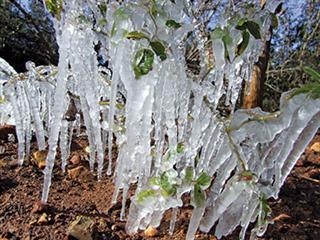
This is usually followed by a warmer spell from 15 to 20 May. Then the severe frost usually begins. The first light frost has the advantage of starting off ‘cold hardening’ in the crop, which makes the effect of the later severe frosts less damaging.
But each year is slightly different. I remember a short while ago we had no early light frost – instead, a very severe cold front came through on 19 May. It did terrific damage, burning all the leaves off the beet and Swiss chard and damaging most winter crops to some extent.
Plan for winter planting by selecting the warmer lands for the colder periods. The tops of these slopes might be cooler in the day, but they’ll be much warmer at night as the cold air sinks to the lowest parts. As ‘frost time’ approaches, monitor the weather forecasts very closely. This is not to say you should believe the forecast temperatures unreservedly. The lows have never been accurately forecast in my area. They’re always higher. With the cold front likely to come from the south-west, check the actual temperatures of areas in its path a day or so before its arrival – and you’ll get a better idea of what to expect.
More vulnerable
A crop under drought-stress is far more vulnerable to frost damage. I’m not sure why this is and would appreciate an explanation from someone who does know. A crop just irrigated, with free water on the leaves and wet soil, will have a much lower night temperature than a crop where the soil is moist but the leaves and soil surface are dry.
Those who grow crops in enclosed structures use a wet wall in hot weather. Water dripping down the wall evaporates due to air being drawn by fans into the enclosure, cooling the interior by many degrees. When a land is wet, the leaves and soil surface act as a wet wall, lowering the temperature as dry air flows over it. Such a land will be several degrees cooler than would otherwise be the case, and thus much more vulnerable to damage.
Overhead irrigation
Cold fronts in winter arrive with strong, dry winds during the day. By nightfall, when the wind drops, the land is already much colder than it would normally be and by morning the damage will be evident. Never use overhead irrigation in the teeth of a cold front wind! Ensure your lands have enough water before a front is expected and then hold back until it has passed.
In cold weather it is better to stop overhead irrigation by midday on crops which are likely to be slowed down too much by more cold, even when there’s no cold front.
You can also irrigate the crop in the early hours of the morning to prevent frost forming. This will either be good or bad, depending on the severity of the frost. A crop which is frost susceptible would normally be grown in an area where frosts usually don’t occur or are very light. In such cases, this practice will be successful, especially if the water is fairly warm.
If it’s cold enough for the irrigated water to freeze, the frost damage will be much more severe and it’s better not to irrigate. You can also harden crops in advance of the expected cold period by placing them under slight drought stress well in advance of the time and by not overdoing nitrogen. I used to have a photo of a lettuce land which was over stimulated by nitrogen and a section missed. The missed section was fine after a heavy frost and the rest burnt black.
Contact Bill Kerr at [email protected]. Please state ‘Vegetable production’ in the subject line of your email.











